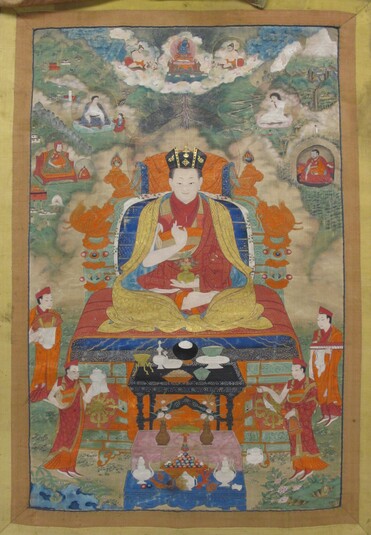
Item: Teacher (Lama) - Karmapa 9, Wangchug Dorje
| Origin Location | Tibet |
|---|---|
| Date Range | 1700 - 1799 |
| Lineages | Karma (Kagyu), Drukpa (Kagyu) and Buddhist |
| Material | Ground Mineral Pigment on Cotton |
| Collection | Private |
Wangchug Dorje, the 9th Karmapa, (1555-1603): a great traveler, scholar and practitioner. Well educated and a moderately prolific writer, two of his more important compositions on mahamudra were the 'Ocean of Certainty' and 'Eliminating the Darkness of Ignorance.' Amongst his many famous students was Jonang Taranatha.
 Kar ma pa
Kar ma pa  Biographical Details
Biographical Details
The central figure is identified as the 9th Karmapa, aside from the black hat, because of the right hand upraised in a gesture of blessing and the left hand holding a vase. The 9th Karmapa is generally depicted either in this fashion or with the right hand extended across the knee and the left hand alternately holding a book in the lap. Of the sixteen Karmapas to appear in art with general iconographic characteristics, no other of the fifteen Karmapas has this consistent specific depiction, albeit with two variations.
The large central figure of Wangchug Dorje wears the typical black hat common to all recognized rebirths in the Karmapa incarnation lineage. He holds the right hand up to the heart in a gesture of blessing and the left hand in the lap holds a long-life vase. Wearing the red and orange robes of a fully ordained monk, he also wears an outer meditation cloak, gold and richly patterned. Karmapa sits on a cushioned throne with an ornate backrest of Chinese style with two dragon heads looking inwards at the seated figure. A large black lacquer table supports victuals and libations while again in front two more tables, pink and blue, present offerings, jewels and precious substances - real and imagined.
In the foreground, four attendant figures wearing monastic robes and red caps attend to the seated central figure of Karmapa. The attendant at the upper left offers a hat, large and fan-like, held with a white scarf. The attendant below offers tea from a round white teapot, held aloft, with a white scarf. The attendant at the upper right offers a Tibetan folio text, red and long, with a white scarf. The attendant below waves a metal censor, wafting incense, held by a gold chain in the right hand. The left hand holds a bag of precious incense in a striped woven cloth bag decorated with frills along the bottom.
Directly behind and above Karmapa is a tree trunk, with curved and knotty branches, tall, extending into the clouds, white, pink, yellow and blue, which pool to form a pond of blue water, rolling waves, with lotuses supporting a throne and pink lotus seat for the primordial Buddha Vajradhara, blue in colour. On the viewer's left is the Indian mahasiddha Tilopa and on the right side is Naropa - both are accompanied by an attendant figure - female.
Slightly lower than the top center, on the left side, is Marpa Chokyi Lodro and consort, Dagmema. Below that is the famous student of Milarepa, Gampopa Sonam Rinchen, wearing the robes of a monk and the hat which he designed. To the side of the throne sits Pagmodrupa - founder of the Eight Minor Kagyu Traditions (such as Drugpa Kagyu), slightly disheveled, balding and with a growth of facial hair.
Below Vajradhara on the right side is Milarepa, yogi and poet, student of Marpa, wearing the traditional white robes of a yogi and a red meditation belt, cupping his ear while singing to six figures seated in front. Below that is once again Pagmodrupa, with monastic robes, seated in a grass meditation hut, situated in a dense green forest.
Although this painting depicts a Karmapa as the central figure it is most likely a Drugpa Kagyu creation and part of a much larger composition. At this time the intention of the complete creation is not yet understood.
There are no apparent inscriptions on the front of the painting. There are however inscriptions on the verso but they were applied long after the painting was created. Some inscriptions are in a modern gold paint and others are written with a pen. Likely the inscriptions were applied by a former owner in the 20th century. Therefore, the inscriptions on the back are neither informative nor reliable.
This painting is the first composition in a set of paintings. We know this because at the back of the painting, top of the cloth mounting, there is the single Tibetan word 'tsowo.' This means 'main' or' principal.' It is the standard term written on the back of a painting to indicate number one or the center piece in a set. There is no way at this time to determine how many other paintings were in the complete set.
Jeff Watt 8-2010
Teacher: Karmapa Wangchug Dorje, 9th Masterworks
Teacher: Karmapa (Masterworks)
Teacher: Karmapa Wangchug Dorje, 9th
Incarnation Lineage: Gyalwa Karmapa Main Page
Chinese Language: 中文主页, Main Page
Incarnation Lineage: Gyalwa Karmapa Art History









